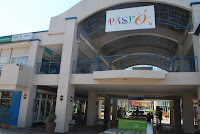From the
documentary that I have watched during the class was about Filipino food
culture. It was very interesting film because I was able to interconnect the
political issue, specifically post-colonialism, with food culture in the
Philippines.
The documentary
was titled as ‘No Reservation’ and it was all about the food and cultural trip
led by Anthony Bourdain. He travels all over the countries and experiences the
culture, especially through food. It seemed that he enjoys the Filipino dishes
including lecheon, sisig, and other street food.
 |
| <Documentary 'No Reservation'> |
No difference
with him, I do really like Filipino food. What I like the most are sisig and ballot.
The reason behind my preference is this; a unique and traditional food that
could only be found in the Philippines. One day, my professor asked our
classmates the reason why there are no fine restaurants in other countries
while there are prevalent fine Vietnamese, Thai, and, Arab restaurants. The most
supported answer regarding this question was ‘because Filipinos value kinship
or network rather than the food itself. With whom you are with is much more
important than what you eat’. I agree on this argument. I, however, would like
to answer his question by elaborating my supports from post-colonial era. From
now on, I would like to write my personal opinion and it might seem to be
discriminating Filipino culture when reasoning out this question. But I do not
have any offense to any Filipino culture, rather, I am just writing my own
opinion based on my understanding regarding lack/absence of fine Filipino
restaurants in other countries.
The Philippines
has been colonized by three different countries; Spain, America, and Japan. On
the process of colonization, Filipinos accepted several culture, practice,
traits, and, even, food from its colonizers. The key point of success in terms
of colonization is harmony through hybridity of Filipino and colonizer’s
culture. Once the culture is rejected by the mass, it gradually declines and
disappears in the end. Japanese colonization could be perfect example for this.
Even though Japan colonized the Philippines before World War II, no or rare
cultural traits, practices, or tradition is remained among Filipinos. American
and Spaniard colonization, on the other hand, could be considered as the most
influenced ones in the Philippines.
Based on my
research and observation, BBQ and Lecheon came from America and Spain. Mixing
them with vinegar and calamansi and eating with all family members could be
seen only as Filipino indigenous culture. The hybridity of Western food and
indigenous practices completes the work of post-colonialism and explains its survival
in present time.
I do not
consider barbeque and lecheon as indigenous Filipino dishes rather as Western. If
I ask other foreigners, they also do not consider these as Filipino food.
Moreover, if I ask any of my foreign friends except Filipinos or those who have
been to the Philippines, their main idea on Filipino food are fruits such as
mango, pineapple, and banana rather than any fine dishes.
In order for Filipino
fine restaurant to be prevalent, I would suggest two advice. First, promote the
dishes that are really unique and indigenous rather than popular dishes in the
Philippines. Second, develop popular dishes by empowering Filipino traits in
terms of taste, decoration, or any other unique Filipino culture on the way of
eating the food.
Through the
passage, I am not saying that all popular food are not indigenous Filipino food
because the hybridity of culture creates another unique Filipino culture. In
other word, there should be a movement on creating its own image of food from
the hybrid outcome on which the Western image is more strengthened than indigenous
culture.


















.jpg)



